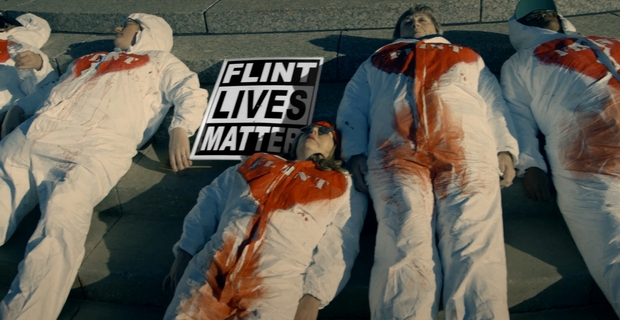Review: Flint (2020)

Once synonymous with the booming American automotive industry, the city of Flint, Michigan has become an example of all downsides of de-industrialization and urban decay laced with depopulation, high poverty and violent crime rates. Known also as the home town of the documentary filmmaker Michael Moore, the town also served as an example of what is going wrong with the contemporary America in his films.
Until recently, Flint has only played supporting roles in news and documentaries, but the Scottish filmmaker Anthony Baxter, previously known for his exposé documentaries on Donald Trump’s land development shenanigans and the dangers that the golfing resort industry brings with itself (the titles include You’ve Been Trumped, A Dangerous Game and You’ve Been Trumped Too), decided to turn Flint into a star of his new documentary. In his standard manner, the filmmaker has created a chronicle of a still-ongoing affair of the water poisoning in the town, causing outbreaks of the different deceases, protests and general distrust towards the government. Flint has premiered earlies this year at Glasgow International Film Festival and is now available at the web edition of Sheffield Doc/Fest.
Detailed and chronologically clear in its scope, Flint could be sub-titled “Anatomy of a Sh*tstorm”. It all began with the switch of the water supply for the town from Lake Huron to the local Flint River. That move was designed by the film’s chief antagonist, the Republican governor of Michigan, Rick Snyder, a man who comes from the business background and who decided to govern the state in the same manner as he would do with a company. The goal was to save money on water supply, but the trouble was that the river was severely polluted, as it served as a dumping ground for various GM plants. Additionally, the water plant planners have somehow forgotten about the corrosion risk, so the water was highly corrosive, affecting the pipes in the local water works that were all made of lead. The result: the high level of lead and copper ended up in the local water.
It all started with rashes and skin infections, but soon enough lead poisoning took other turns, raising the level of stillborn children and miscarriages and an outbreak of the legionnaires’ disease. The measures taken by the state government came too late and were to weak to solve the crisis, while the city’s depleted budget prevented the local authorities to take the sufficient action on their own. The citizens organized themselves in activist groups to try to do something and help those in trouble. Some independent organizations joined in, at first and most notably, Virginia Tech University and its professor Mark Edwards who did the initial water quality tests and published them, forcing those in power to take action. Soon enough, the organization called Water Defense, founded by the actor Mark Ruffalo and represented by the self-called scientist Scott Smith, also showed up to draw the rift between the citizens on one side and the official agencies and the academia on the other.

The approach Baxter takes is honest and sincere, putting the citizen-activists and those who suffer from the water-induced conditions in the spotlight, providing them with an ear keen to listen and an observant camera. The largely hand-held shots by Baxter himself from the homes, the press conferences and the group meetings are combined with the aerial footage of the town done by Edward Bally and the archival footage from different news media for the sake of the additional dynamics necessary for the viewers to swallow a slightly bloated nearly two-hour format. Baxter’s own editing is smooth, the often-employed graphics are informative and illustrative, but non-intrusive, while the string orchestra score by Dominic Glynn is quite effective.
The ease with which Baxter switches from one topic of the affair to the other is refreshing and in synch with certain topics being key for the certain stages of the affair. The director prefers to stay behind camera, but is not shy to pose a question or even step into the frame himself when he feels needed. Another great asset and possibly a good selling point, especially on the American market, is Alec Baldwin as the film’s narrator with a voice that signals the integrity and the authority as well as the basic human care. The good impression the film leaves is slightly impaired at the very end, with Baxter’s insisting on the role of the interviewer and Baldwin’s appearance in the few scenes that does not benefit the whole project in the terms of the cinematic value, but leaves the taste of a vanity fair in a similar fashion as Ruffalo’s involvement with Water Defense does.
Although Flint would work better if it were either some 10 or 15 minutes shorter, or divided in 3 or 4 episodes of a series with some additional focus on the wider socio-economical context of the town and its citizens, it is still by no means a bad documentary. However, its primary value does not come from the cinematic merits, but from its news-worthy urgency. It is a strong exposé of the government negligence and incapability and the consequences they leave on the citizens in the long run.
Original title: Flint
Year: 2020
Runtime: 119′
Country: UK
Language: English
Directed by: Anthony Baxter
Written by: Richard Phinney
Narrated by: Alec Baldwin
Cinematography by: Anthony Baxter, Edward Bally
Editing by: Anthony Baxter
Music by: Dominic Glynn
Executive producers: Mark Thomas, Alec Baldwin, Casey Bader, Tony Nellany
Produced by: Beatrix Wood, Justin Weinstein, Sabrina Schmidt Gordon, Richard Phinney, Anthony Baxter
Production companies: Montrose Pictures, El Dorado Pictures, BBC Scotland, Cosmic Cat, Creative Scotland
















